previous
next
RegiStax 5.1: New features (FILTERS)
In our search for techniques that improve alignment and optimizing we have been exploring several new options during the development of RegiStax 5.1.Filters during alignment
Alignment/optimisation is one of the most important aspects of creating high quality images. When alignment is difficult additional techniques can be used to improve alignment. Using Filters was added in the intial RegiStax 5 release. The set of filters consisted of :-Blur : Blurs the image before alignment, especially used for image with static noise.
-Gamma/Stretch: both can be used to increase the visibility of structures/features
-Negative: in some images reversing the image-intensity was a helpfull way of increasing visibility of features.
You call these functions simply by pressing the PREFILTER button.
To this set we have added a complete new filter called Gradient. This filter acts very different than all the other filters. In the two images below you can see the original image on the left and the effect of Gradient on the right.
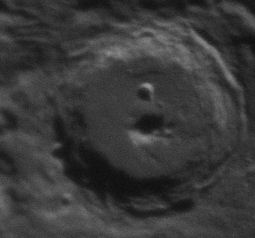
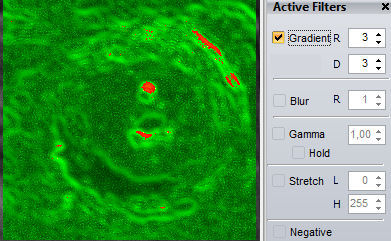
(images courtesy of Bob Pilz)
The above images shows the effect of using this filter. Many structures that are less visible in the original image on the left do show up clearly in the filtered image on the right. The effect of the filter is that image fields with differences (hence the name gradient) in the average intensity-values of adjacent pixels will show up brighter.
The brightness of the new image corresponds to the strength of the gradient in the image.
The red areas show that this image was not filtered correctly yet, these need to be corrected
The filter comes with 2 settings, R (radius) and D (dividor). R can be set to values 1,2 and 3. D is used to control the appearance of areas where the gradient is too large (red).
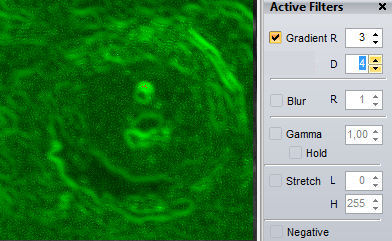
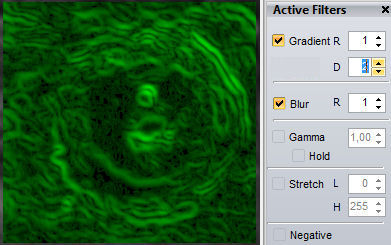
After changing the values for R and D and also adding a Blur filter we get a very nicely defined view of the crater and parts that can be used for alignment.
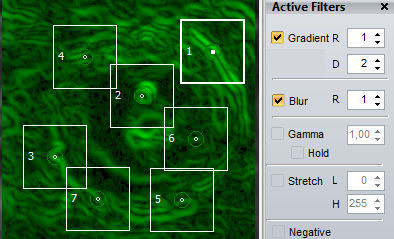
After using the "estimate alignpoints" function the program is ready to align.
Filters during optimisation
One of the new options in RegiStax 5.1 is that you can also use the filters (like gradient etc) during optimisation. Since filtering images does cost computing time you can also decide to do the initial alignment (if there are no real problems in aligning) using no filters and only switch to using the filters at the optimizer-stage. You can change the filters at will before optimising or restart optimising using a new setup of the filters. When you start (press the PREFILTER button) the filters at the optimising stage you will see the effect of the filter on the screen.This functionality is also very usefull when you use "Create-Reference" or "Realign with Processed" to improve the referenceframe.
